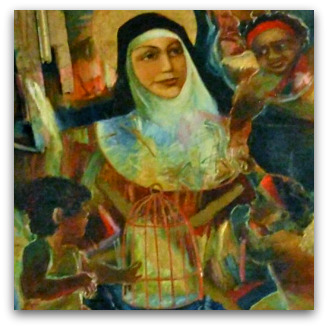 Like script writers who adapt Jane Austen's novels for television, contributors to Catholic magazines these weeks will ache all over from wrestling with relevance. How to make Elizabeth Bennett into a thoroughly modern young woman? And how to make Mary MacKillop into a Saint for Australia of the 21st century?
Like script writers who adapt Jane Austen's novels for television, contributors to Catholic magazines these weeks will ache all over from wrestling with relevance. How to make Elizabeth Bennett into a thoroughly modern young woman? And how to make Mary MacKillop into a Saint for Australia of the 21st century?
It is possible to represent Mackillop as a brave woman, a feisty woman, her own woman, a feminist before her time, a woman who resisted clerical tyranny, a scourge of pedophilia and an activist for the poor, an Australian of our own day. And to illustrate each representation by dramatic stories.
The pictures we draw may be inspiring. Yet we will finish disconcertingly aware that we have missed what was central in her. And we may suspect that what was central in her is quite strange to 21st century Australia.
If Mary was her own person, for example, she spent much of her energy being someone else's person. She wanted to give herself to God in religious life, and adopted a dress that prevented herself expressing her individuality.
More significantly, she committed herself and her sisters to find God's will through obedience to other human beings. She accepted the guidance of the unreliable Julian Tenison Woods until he returned off-stage. And for many years after she had been dismissed as Superior of the Congregation on false charges in a rigged process, she acted as an assistant to Mother Bernard, who was timid, indecisive and lacking in vision. She accepted the great suffering that this entailed because she saw it as the place where the rubber of faith hit the road.
For a feisty and rebellious woman she had a singular gift for keeping her silences. She never sought publicity for her grievances and even in her private letters she always made accommodations for people who treated her badly. She was certainly adamantine in defending the nature of her Congregation against those who wanted to change it. But she was not defending autonomy. What was at stake was the content of the vows by which she and the Josephites had limited their autonomy for their common work. It was about the terms of their service of God.
MacKillop was also humanitarian in her commitment to improve the life of poor children and their families. But what mattered to her most was their relationship with God. When she visited jails and schools, her conversation with prisoners, students and parents turned quickly to the place of God in their lives.
The Josephite schools, too, gave much time to prayer, religious instruction and to singing hymns. They moved naturally and easily from being local initiatives to being part of a wider Catholic school system that offered a deliberate alternative to secular education. In them faith was central.
Faith indeed was central to MacKillop. It was expressed in her life in the Catholic Church and animated her own personal response to injustices and her commitment to educating the poor. It was at the heart of what mattered and how she responded to what mattered. Her picture in heavy veil and the popular focus on her miracles reflect her difference.
These differences between MacKillop and contemporary values may seem to rule against seeing her as a saint for 21st century Australians. But paradoxically, the aspects of life that seem most alien to 21st century Australia make her an illuminating figure for our day. It was not in spite of the fact that she did not share the values of our society that she made an extraordinary contribution to Australian life. It was because she did not share them that she did such remarkable and generous things.
This challenges the common assumption that people whom we admire really share our view of the world even though they come from different backgrounds. If people who have made a great contribution to society are Marxists, Communists, Greens, Catholics, atheists or members of any other group of whom we are suspicious, we assume that they could not have been motivated by their distinctive beliefs.
Once we recognise that great Australians can act heroically precisely because they have a very different view of the world than we do, we shall be encouraged towards a tolerance that is based on interest in those who are different, not on dismissal. We may also be led to reflect critically on the values of our society and on the extent to which they encourage generosity and faithfulness.
It will also draw us back to ask what matters to us, and how that is reflected in our actions. In that respect MacKillop, like all people of integrity, is a great reality test both for Australians and for Catholics.
 Andrew Hamilton is the consulting editor for Eureka Street. He teaches at the United Faculty of Theology in Melbourne.
Andrew Hamilton is the consulting editor for Eureka Street. He teaches at the United Faculty of Theology in Melbourne.